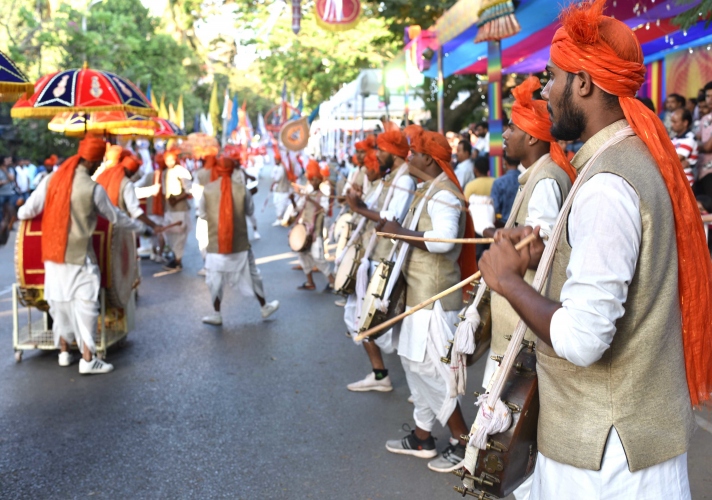
A file photo of Shigmo festivities in the State.
Shigmo is a spring festival in Goa celebrated with traditional fervour in the Phalguna month, according to the Saka calendar of the Hindu community. It is the festival of colours, dance, and music and also well-lit colourful float parades in the State and it is a state-sponsored tourist event. This year, the State government has cancelled the Shigmo festival parades on account of a rise in Covid cases.
The word Shigmo is a Konkani term coined from the Prakrit word 'Suggimaho' and Sanskrit word 'Sugrishmaka'. There are two variants to the Shigmo festival: the Dhakto Shigmo (Small Shigmo) and the Vhadlo Shigmo (Big Shigmo).
During this festival period, famous temple processions are held by throwing Gulal (red powder) and dancing with umbrellas, symbols of gods and goddess.
ORIGINS
Shigmo festival was celebrated to honour the homecoming warriors who left their families back home at the end of Dussehra to fight the invaders. They were welcomed with various traditional folk dance performances and enacting various scenes from mythological stories.
Others attribute the celebration of the festival to commemorate the death of Putana by Lord Krishna. The festival is also celebrated to mark the farewell of the winter season and welcome spring. It is also celebrated in the memory of the Indian cupid Lord Kamadeva cursed by the anger of Lord Shiva for the audacity of the former, to disturb him while he was in penance.
The Dhakto Shigmo is generally celebrated by farmers and labour class in the South Goa by menfolk performing various traditional folk dances. The Vhadlo Shigmo on the other hand is celebrated by everyone on a major scale in north Goan villages and is all-inclusive. It mainly includes 'Romat', a procession-cum-dance that creates the festive mood of the entire region.
CELEBRATIONS
Dhakto Shigmo can be described as the festival of songs and traditional dances, celebrated with a lot of excitement and joy by the rural population of Goa. The festival begins five days before the full moon of the Indian lunar month of Phalguna and ends on the full moon day. This is the culmination of the Shigmo with Holi Poornima, while the Vhadlo Shigmo ends on the fifth day of the festival called Rang Panchami and is the day of rejoicing.
This day is celebrated much like the Hindu Holi festival, with Gulal (red powder). On the 11th to 15th moon day, the villagers set out with high spirits and a festive mood, clad in vibrant, colourful attire with toran or flags in their hands.
They also carry column-like, red spotted dwajas, blowing flutes and beating drums only to gather at the village temple and dance in the temple court yard singing various folk songs to the beat of the drums.
Villagers wearing colourful dresses gather at a specific determined place and sing the Naman song, followed by the Jot song. Various kinds of dances such as Tonayam mel, Lamp Dance, Goph, Talgadi, Morulo and Chowrang are performed by the villagers.
People visit houses dancing to the beats of drums such as Ghumott, Shamel, Taso and Dhol. Seeing the performances, household people donate money. This is followed by singing the Tali song, which is sung by performers as a token of blessings to the donors.
On the other hand, Vhadlo Shigmo is mainly performed in village temples. During the five days of Vhadlo Shigmo, different traditional performances are staged in almost all villages, supported with festive music. In the temples, the deity is dressed with a ceremonial cloth of saffron colour. Food is offered to the deity, followed by an extensive meal by the villagers.
Shigmo celebrations by sprinkling Gulal in the temples of Zambaulim, Fatorpa, Kansarpal and Dhargal are very famous in Goa and neighbouring states and attracts a large number of devotees and tourists.
In recent years, the State government has publicly supported Shigmo street parades consisting of traditional folk dances, street dancers and elaborately built floats, depicting scenes from regional mythology and other religious scenes.
Spectacular Shigmo street parades are held annually in major cities like Panjim, Margao, Ponda, Mapuca and Vasco.
(The writer is former director of Thomas Stephens Konknni Kendr at Porvorim)